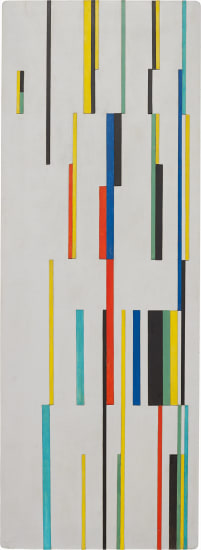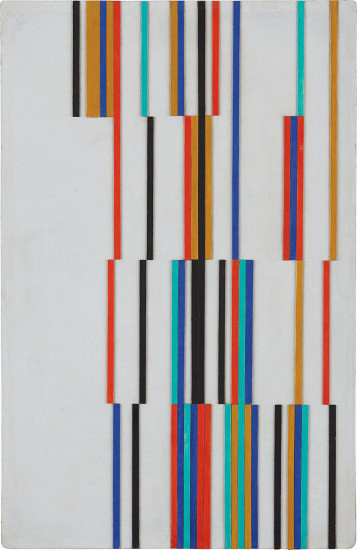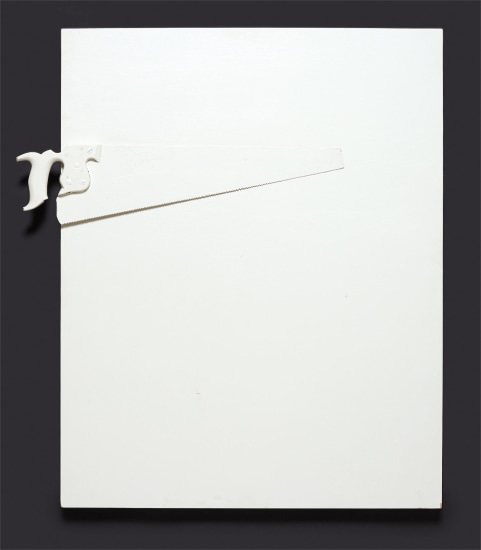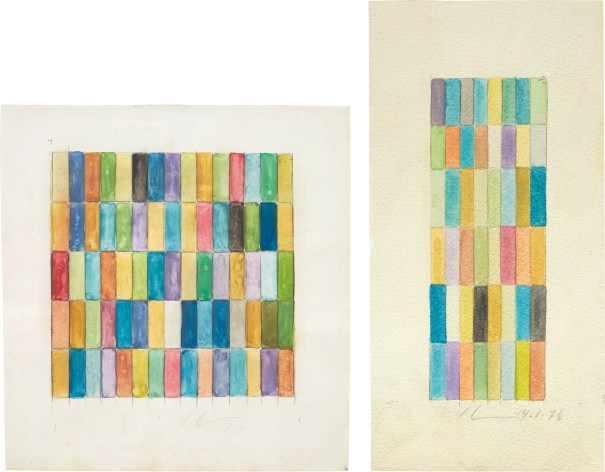Alejandro Otero Untitled 1984 painted strips of board applied to painted wood 27 1/4 x 10 in. (69.2 x 25.4 cm) Signed and dated "Alejandro Otero 1984" on the reverse. This work is accompanied by a certificate of authenticity signed by Alejandro, Mercedes and Carolina Otero.
Provenance Gift from the artist to Mr. Ramón Casas Havana,1984 By descent to Private Collection, Havana Acquired from the above by the present owner Catalogue Essay The work of Alejandro Otero has contributed immensely to the development of Venezuelan abstraction, as exemplified by the present lot, Untitled, circa 1965-70, an extraordinarily colorful and rhythmic panel that belongs to a period in the artist’s oeuvre when he consolidated his signature style. Like many of his contemporaries, Alejandro Otero studied and lived in France for five years before returning to Venezuela in 1952 at a pivotal historical moment. During this time, the country was undergoing an accelerated modernization process in which Otero was able to collaborate and participate extensively in far-reaching projects that proposed integrating architecture and art on a grand scale. These collaborative projects significantly informed Otero’s unique brand of art. A prime result of this collaboration was the nine mural reliefs at the José Angel Lamas Amphitheater, made in metal and mosaic; a similar compositional scheme would later be seen in Otero’s famous series of Coloritmos. Another equally important project that influenced Otero’s work was his participation in the famous eighteen story residential building called El Paraíso. This national housing plan was conceived as a way for architects together with artists to design units intended for the emerging middle class that would be a model for a string of superblock housing projects. Both the structure and the color of these units would inform Otero’s future panels. However, the collaboration ultimately came to an end because Otero believed that architects essentially wanted to imitate the artists, effectively excluding them from the process. Thus, Otero returned to painting, rethinking this collaborative work and approaching it from a different angle. This would eventually lead him to a new pictorial notion that would continue to be linked to architecture, which he called “functional integration”. One cannot fully comprehend Otero’s oeuvre without understanding his masterpieces, the Coloritmos, which were some of his most ambitious works, created from 1955-1970. It was in this series that Otero first began using duco, a shiny industrial lacquer that is applied with spray guns or rollers onto supports of wood or Plexiglas. Looking at early panels from this series, the viewer can see how they inform the present lot, where the structure has evenly spaced vertical bands on a white ground and color markings that are interspersed thereby activating the entire structure of the plane. The primordial aspect of these elongated compositional modules is a promotion of rhythm and color over form, suggesting a spatial ambiguity and a rhythm that expands beyond the edges. It is this constructive sensibility that Otero obtained from his architectural training and that would eventually recover the relation between architecture and art. The present lot, very much like the Coloritmos, “overflows the plane, reaches for and embraces architectural space,” as Otero aptly described it, and moves perceptually towards the viewer. Picasso was also a great influence for Otero as the few encounters with the great master made Otero turn to Cubism, such that “Otero experimented with the way lines, colors and planes articulate painting’s abstract spatiality.” (Rina Carvajal, Resonance Space – The Colorhythms of Otero, 2014, p. 64). Additionally, Mondrian inspired Otero as his art taught the younger artist to further experiment with the colored blocks on panels. At first glance, these works seem simple but ambiguity disrupts the contemplative viewing. Ultimately, “with this constitutive ambivalence or doubt at the heart of the series, Otero breaks with the disciplinary order of modernist aesthetics, in which each medium is understood through qualities specific to it, in a way that also points to the return of another modernist dream, that o
Alejandro Otero Untitled 1984 painted strips of board applied to painted wood 27 1/4 x 10 in. (69.2 x 25.4 cm) Signed and dated "Alejandro Otero 1984" on the reverse. This work is accompanied by a certificate of authenticity signed by Alejandro, Mercedes and Carolina Otero.
Provenance Gift from the artist to Mr. Ramón Casas Havana,1984 By descent to Private Collection, Havana Acquired from the above by the present owner Catalogue Essay The work of Alejandro Otero has contributed immensely to the development of Venezuelan abstraction, as exemplified by the present lot, Untitled, circa 1965-70, an extraordinarily colorful and rhythmic panel that belongs to a period in the artist’s oeuvre when he consolidated his signature style. Like many of his contemporaries, Alejandro Otero studied and lived in France for five years before returning to Venezuela in 1952 at a pivotal historical moment. During this time, the country was undergoing an accelerated modernization process in which Otero was able to collaborate and participate extensively in far-reaching projects that proposed integrating architecture and art on a grand scale. These collaborative projects significantly informed Otero’s unique brand of art. A prime result of this collaboration was the nine mural reliefs at the José Angel Lamas Amphitheater, made in metal and mosaic; a similar compositional scheme would later be seen in Otero’s famous series of Coloritmos. Another equally important project that influenced Otero’s work was his participation in the famous eighteen story residential building called El Paraíso. This national housing plan was conceived as a way for architects together with artists to design units intended for the emerging middle class that would be a model for a string of superblock housing projects. Both the structure and the color of these units would inform Otero’s future panels. However, the collaboration ultimately came to an end because Otero believed that architects essentially wanted to imitate the artists, effectively excluding them from the process. Thus, Otero returned to painting, rethinking this collaborative work and approaching it from a different angle. This would eventually lead him to a new pictorial notion that would continue to be linked to architecture, which he called “functional integration”. One cannot fully comprehend Otero’s oeuvre without understanding his masterpieces, the Coloritmos, which were some of his most ambitious works, created from 1955-1970. It was in this series that Otero first began using duco, a shiny industrial lacquer that is applied with spray guns or rollers onto supports of wood or Plexiglas. Looking at early panels from this series, the viewer can see how they inform the present lot, where the structure has evenly spaced vertical bands on a white ground and color markings that are interspersed thereby activating the entire structure of the plane. The primordial aspect of these elongated compositional modules is a promotion of rhythm and color over form, suggesting a spatial ambiguity and a rhythm that expands beyond the edges. It is this constructive sensibility that Otero obtained from his architectural training and that would eventually recover the relation between architecture and art. The present lot, very much like the Coloritmos, “overflows the plane, reaches for and embraces architectural space,” as Otero aptly described it, and moves perceptually towards the viewer. Picasso was also a great influence for Otero as the few encounters with the great master made Otero turn to Cubism, such that “Otero experimented with the way lines, colors and planes articulate painting’s abstract spatiality.” (Rina Carvajal, Resonance Space – The Colorhythms of Otero, 2014, p. 64). Additionally, Mondrian inspired Otero as his art taught the younger artist to further experiment with the colored blocks on panels. At first glance, these works seem simple but ambiguity disrupts the contemplative viewing. Ultimately, “with this constitutive ambivalence or doubt at the heart of the series, Otero breaks with the disciplinary order of modernist aesthetics, in which each medium is understood through qualities specific to it, in a way that also points to the return of another modernist dream, that o







.jpg)




.jpg)
.jpg)
Try LotSearch and its premium features for 7 days - without any costs!
Be notified automatically about new items in upcoming auctions.
Create an alert